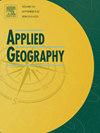Examining the relationship between urban form and social inequality: A neighborhood-level analysis
IF 4
2区 地球科学
Q1 GEOGRAPHY
引用次数: 0
Abstract
Inequality is a pervasive aspect of human life, manifesting spatially and intertwining with urban form and the built environment. While compactness can enhance urban equity, sprawling forms often amplify disparities. This study explores how compactness and sprawl influence spatial and social inequalities at the neighborhood scale in Ahvaz, Iran. Unlike prior studies, it employs multidimensional indicators to examine urban form alongside inequality and population density, addressing both spatial and statistical dimensions. Using Ordinary Least Squares (OLS) and Geographically Weighted Regression (GWR) models, this study evaluates socio-spatial inequalities across 111 neighborhoods. Results reveal that compact neighborhoods generally exhibit lower social and spatial inequality due to better access to urban services, while sprawling areas, particularly in the periphery, face significant inequities. For instance, a one-unit increase in compactness correlates with a 15.2% reduction in social inequality and a 40.5% reduction in spatial inequality. However, the effects of population density vary across neighborhoods; higher density in marginalized areas may exacerbate inequality, necessitating context-sensitive planning. The findings underline the importance of promoting compact urban forms while addressing socio-economic disparities. Recommendations include tailoring urban planning policies to local contexts, improving infrastructure in marginalized neighborhoods, and enhancing service distribution to achieve spatial equity. This research highlights how urban form interventions can mitigate inequalities, contributing to sustainable and resilient urban development in rapidly urbanizing regions like Ahvaz.
求助全文
约1分钟内获得全文
求助全文
来源期刊

Applied Geography
GEOGRAPHY-
CiteScore
8.00
自引率
2.00%
发文量
134
期刊介绍:
Applied Geography is a journal devoted to the publication of research which utilizes geographic approaches (human, physical, nature-society and GIScience) to resolve human problems that have a spatial dimension. These problems may be related to the assessment, management and allocation of the world physical and/or human resources. The underlying rationale of the journal is that only through a clear understanding of the relevant societal, physical, and coupled natural-humans systems can we resolve such problems. Papers are invited on any theme involving the application of geographical theory and methodology in the resolution of human problems.
 求助内容:
求助内容: 应助结果提醒方式:
应助结果提醒方式:


